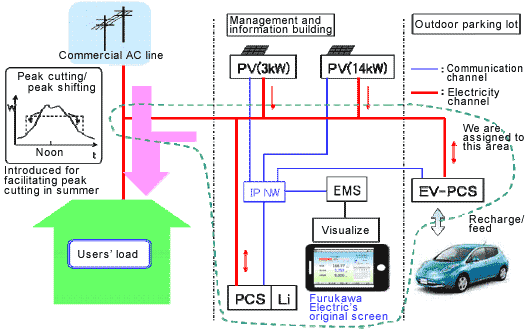July 26, 2012
We have received an order for assigned research for verifying introduction of the Smart Energy System, which was advertised by Electricity Storage System Promotion Division, New Energy and Global Warming Countermeasures Department, Environment and Agriculture Bureau, Kanagawa Prefecture. This is for the power storage system to control daytime peak power with the use of electric vehicles (EVs) and fixed-storage batteries. Verification testing will be conducted at the Kanagawa Industrial Technology Center in Ebina-shi, Kanagawa Prefecture, from August 1, 2012 to the end of March 2013.
Background
The Great East Japan Earthquake led to electricity shortages, and this has increased attention given to the topic of controlling peak power. Approaches to controlling peak power include peak cutting (controlling electricity consumption during peak hours) and peak shifting (using storage batteries, etc. to store nighttime power and discharge it during peak hours). Peak cutting can be further divided into demand control (controlling the amount of users' electricity consumption) and the use of photovoltaic-like power generators to control apparent electricity consumption.
Peak shifting is increasingly gaining attention because of its lesser effects on the electricity grid and in consideration of the need to avoid inconvenience for consumers. Conventionally, peak shifting has not effectively taken hold due to the costs of storage batteries and other necessary items. Boosted by subsidies from the national and local governments as well as low pricing of storage batteries, peak shifting is gradually penetrating the market.
Product (system) description
The Smart Energy System aims to conform to the trend toward controlling peak electricity demand in the summer, and to reduce electricity rates (rates for 160 kW are cut by 15%) by reducing contract demand and by using less expensive nighttime power.
Figure 1 illustrates the Smart Energy System. This consists of a power conditioning system (PCS)(note 1), lithium (Li) storage battery, EV-PCS(note 2), a visualization system (electricity consumption is monitored and the amount of electricity is visually shown to calculate and display cost) and an energy management system (EMS)(note 3).
Conventionally, electric discharge from using an electric vehicle as a storage battery has involved separation from the grid (commercial AC line). The Smart Energy System is characterized by electrical discharge without disconnection from the grid. Moreover, it controls multiple storage batteries. This is the industry's first verification test for the Smart Energy System.
We have developed the communication protocol for controlling the overall design of the system and multiple PCS's, the visualization software with viewable information about electricity consumption and the amount of discharge, and the EMS software which facilitates the discharge from multiple PCS's in accordance with the amount of electricity consumed.
A larger version of this product can also be proposed. The Smart Energy System project expects sales of 300 million yen in fiscal 2013.

Figure 1: Smart Energy System configuration
Product (system) features
- PCS output: 10 kW (integrated with Li storage battery)
- Li storage battery capacity: 12.5 kWh
- EV-PCS output: 10 kW (limited to 6 kW LEAF output)
- Visualization system: Monitors the volume of electricity consumed on the commercial line, volume of photovoltaic (PV) power generation, and volume of storage battery discharge, and visually displays these data.
- EMS: PCS and EV-PCS are controlled to prevent electricity consumption from exceeding a certain level.
- After the experiment, the Smart Energy System will remain and be exhibited at the Industrial Technology Center (Ebina) for demonstrations for small- and medium-sized companies.
Glossary
(note 1)PCS: power conditioning system. This is a device for converting DC to AC, or vice versa. It facilitates connection of DC and commercial AC that are input and output via photovoltaics (PV) and storage batteries. Back to Main Content
(note 2)EV-PCS: This type of PCS charges and discharges an electric vehicle Back to Main Content
(note 3)EMS: energy management system. This controls multiple storage batteries and facilitates peak shifting to prevent peak power from exceeding a certain value. Back to Main Content